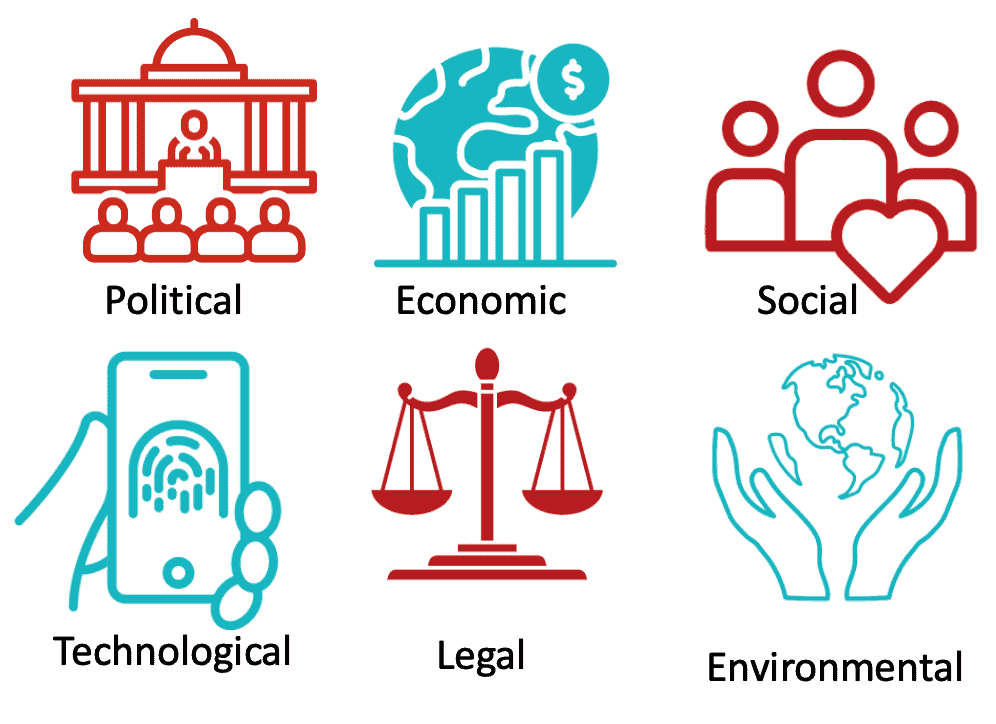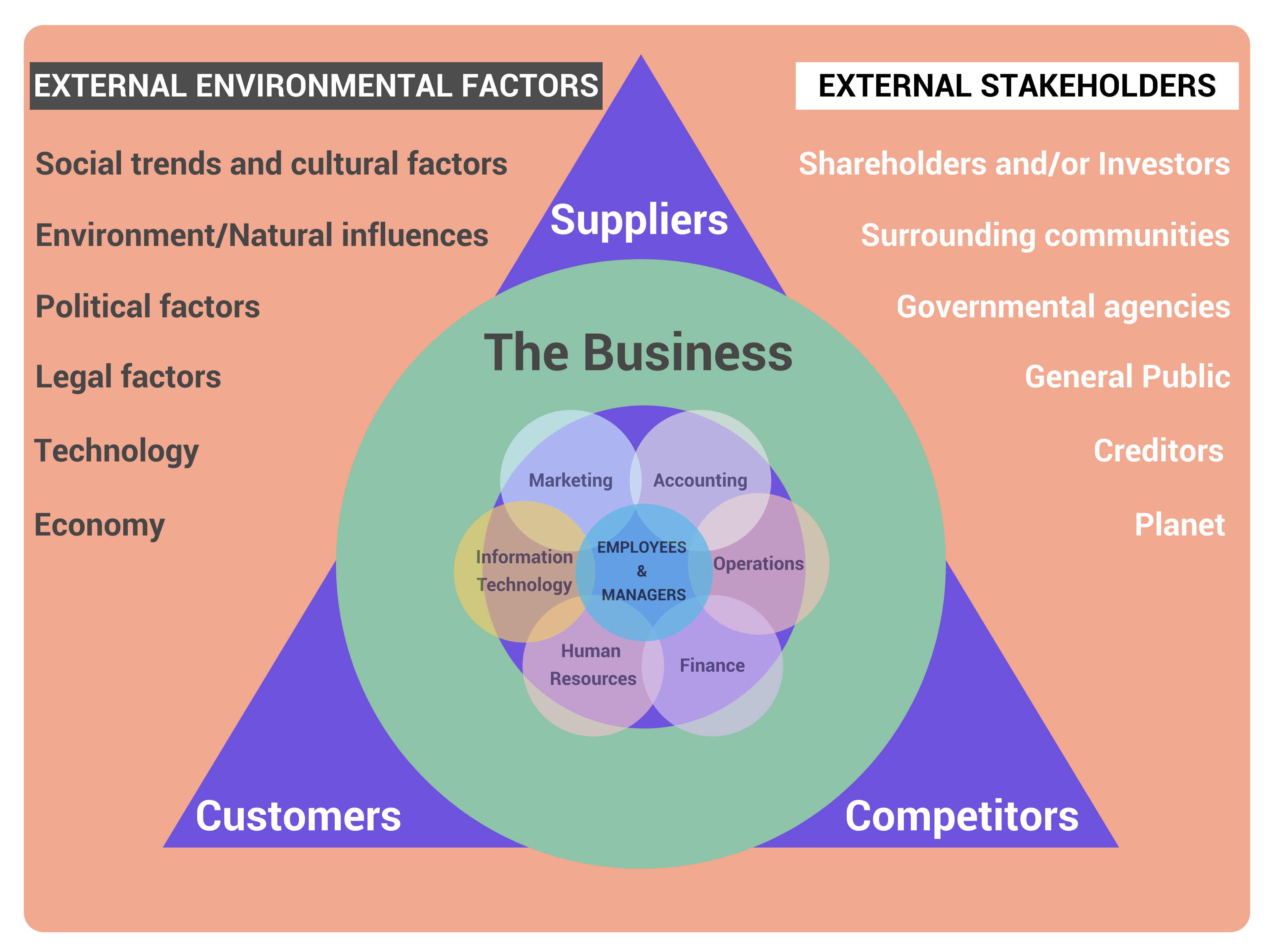The business environment is composed of external factors such as political, economic, social, technological, and legal factors. These factors influence the operations and decision-making processes of businesses.
Businesses need to analyze and adapt to these environmental factors to ensure their success and sustainability. This article will provide insights into the different categories of the business environment and explain the importance of understanding and analyzing these factors for business analysis and decision-making.
Additionally, it will explore various environmental analysis tools that can help businesses assess and respond to the external factors affecting their operations. By understanding and adapting to the business environment, businesses can effectively navigate challenges and seize opportunities for growth and success.

Credit: businessanalystmentor.com
Understanding Business Environment Factors
The success of a business is not only determined by its internal operations and strategies, but also by various external factors that shape its environment. These external factors, collectively known as business environment factors, play a crucial role in influencing the success or failure of a business.
Definition
Business environment factors refer to the external elements that have an impact on the operations and performance of a business. These factors can include political, economic, social, technological, environmental, and legal aspects that shape the overall business landscape. Understanding these factors is essential for businesses to adapt, respond, and thrive in a constantly evolving business environment.
Categories Of Business Environment
The business environment can be categorized into various dimensions, each with its own set of factors that affect business operations. These categories include:
- Economic environment
- Political environment
- Social environment
- Technological environment
- Legal environment
Environmental Analysis Tools
Conducting a thorough analysis of the business environment factors is crucial for businesses to make informed decisions and develop effective strategies. Several tools and techniques are available to analyze and understand these factors. Some commonly used environmental analysis tools include:
- PEST analysis: This tool helps in assessing the political, economic, social, and technological factors that can impact a business.
- SWOT analysis: This analysis focuses on identifying the strengths, weaknesses, opportunities, and threats that a business faces in its environment.
- Porter’s Five Forces analysis: This framework helps in evaluating the competitive forces within an industry that can affect a business’s profitability.
- Five Whys: This tool is used to identify the root causes of a problem or issue, allowing businesses to address underlying environmental factors.
By utilizing these environmental analysis tools, businesses can gain valuable insights into the external factors that can influence their performance, enabling them to make informed decisions and take proactive measures.
External Factors In Business
External factors greatly influence the business environment, encompassing political, economic, sociocultural, technological, environmental, and legal aspects. These factors play a pivotal role in shaping a company’s operations, market dynamics, and strategic decisions, thus highlighting the significance of being attentive to external influences.
In today’s highly competitive and ever-changing business landscape, it is imperative for companies to understand and adapt to the external factors that can significantly impact their operations. These external factors can originate from various sources such as the political, economic, sociocultural, technological, environmental, and legal realms. By identifying and analyzing these factors, businesses can better navigate challenges, capitalize on opportunities, and ultimately thrive in their respective industries. In this article, we will delve into the different types of external factors and explore their impact on businesses.
Types Of External Factors
External factors in business can be categorized into several key domains:
- Political environment:
- Economic environment:
- Social environment:
- Technological environment:
- Environmental factors:
- Legal environment:
The political environment encompasses government policies, regulations, and political stability. It influences business operations through laws and regulations that companies must adhere to, as well as political events that can disrupt or create opportunities within the market.
The economic environment encompasses factors such as inflation, exchange rates, interest rates, and economic growth. These factors affect consumer purchasing power, market demand, and overall business profitability.
The social environment includes societal values, demographics, cultural norms, and consumer preferences. It shapes consumer behavior, market trends, and the overall demand for products and services.
The technological environment comprises advancements in technology, innovation, and the digital landscape. It influences how businesses operate, communicate, and deliver products and services, as well as the level of competition within the industry.
The environmental factors refer to elements such as climate change, natural disasters, and sustainability concerns. These factors can directly impact industries reliant on natural resources, as well as influence consumer perception and demand for environmentally-friendly products and practices.
The legal environment encompasses laws, regulations, and legal frameworks that govern business activities. Compliance with these legal requirements is essential to avoid penalties and ensure ethical business practices.
Impact Of External Factors
The impact of external factors on businesses can be profound. These factors can influence strategic decision-making, market positioning, operational efficiency, and overall business sustainability. Understanding the impact of external factors is crucial for businesses to:
- Anticipate and adapt to changing market conditions
- Identify new market opportunities and consumer trends
- Manage risks and navigate regulatory challenges
- Enhance competitive advantage through innovation and technological advancements
- Build strong relationships with key stakeholders, including customers, suppliers, and the community
By proactively monitoring and responding to external factors, businesses can stay agile and resilient in an increasingly dynamic business environment.
Key Influences In The Business Environment
There are several key influences that shape the business environment. These factors have a significant impact on how businesses operate and make strategic decisions. Understanding these influences is crucial for businesses looking to stay competitive and adapt to changing circumstances.
Technology
Technology is one of the most influential factors in the business environment. Advancements in technology have revolutionized the way companies operate and communicate. From the rise of e-commerce to the use of artificial intelligence, businesses must embrace technology to stay ahead. Technology not only improves efficiency and productivity, but it also opens up new opportunities for growth and innovation.
Politics
Political factors have a direct impact on businesses, as governmental decisions and policies shape the business environment. Changes in regulations, taxation, and trade agreements can greatly influence the profitability and operations of businesses. Companies need to closely monitor political developments and adapt their strategies accordingly to mitigate risks and leverage opportunities.
Competition
Competition is a constant influence in the business environment. Companies operate in a dynamic landscape where rivalry among competitors is fierce. Keeping a close eye on competitors and their strategies is essential for businesses to differentiate themselves and maintain a competitive edge. By understanding and analyzing their competition, businesses can proactively respond to market trends and customer demands.
Ethics
Ethical considerations play a vital role in today’s business environment. Consumers are increasingly conscious of ethical practices and expect businesses to act responsibly. Companies that prioritize ethical conduct can improve their reputation, build trust with customers, and create long-term sustainability. Ethical decision-making should be integrated into the core values and operations of a business.
Natural Environment
The natural environment is an often-overlooked factor that can significantly impact businesses. Climate change, scarcity of resources, and environmental regulations are all factors that businesses need to consider. Adopting eco-friendly practices and incorporating sustainability into business strategies can not only protect the environment but also lead to cost savings and enhanced brand image.
To summarize, technology, politics, competition, ethics, and the natural environment are key influences in the business environment. By understanding these factors and their impact, businesses can effectively navigate challenges and seize opportunities for growth and success.

Credit: www.researchgate.net
Environmental Factors Affecting Business
The business environment is influenced by various external factors that directly impact the operations and success of a business. These external factors can include environmental, social, and economic elements, among others. Understanding these environmental factors affecting businesses is crucial for making informed decisions and devising effective strategies to navigate the ever-changing business landscape.
Examples Of Environmental Factors
Environmental factors affecting businesses encompass a wide range of aspects, including:
- Regulatory policies and government regulations
- Climate change and environmental sustainability
- Natural disasters and environmental hazards
- Resource availability and scarcity
- Energy consumption and efficiency
Role Of Social Factors
Social factors play a significant role in influencing how businesses operate and interact with their target markets. These factors may include:
- Cultural norms and values
- Demographics and population trends
- Social behaviors and lifestyles
- Consumer preferences and buying patterns
- Public attitudes and opinion shifts
Role Of Economic Factors
Economic factors exert a substantial impact on the business environment, affecting financial decisions and market dynamics. Key economic factors include:
- Market demand and supply dynamics
- Inflation and exchange rate fluctuations
- Income levels and purchasing power
- Employment rates and labor market conditions
- Economic policies and trade regulations

Credit: pressbooks.bccampus.ca
Frequently Asked Questions On Business Environment Factor
What Are The 5 Elements Of The Business Environment?
The five elements of the business environment are: 1. Economical environment 2. Political environment 3. Social environment 4. Technological environment 5. Legal environment.
What Are The 10 Environmental Factors?
The 10 environmental factors that can affect business include economic, political, social, technological, legal, Osmolarity, pH, temperature, oxygen concentration, and pressure. These factors play a major role in business decisions and processes.
What Are The 5 Factors Of The External Business Environment?
The 5 factors of the external business environment are: 1. Political environment 2. Economical environment 3. Social environment 4. Technological environment 5. Legal environment.
What Are The 3 Main Business Environments?
The three main business environments are the economical, political, and social environments. These factors have a significant impact on a business and its operations.
Conclusion
Understanding the business environment is crucial for the success of any business. The external factors such as political, economic, technological, and legal factors can greatly impact the operations and growth of a business. It is important for businesses to conduct environmental analysis using tools like PEST analysis, SWOT analysis, and Porter’s five forces analysis to stay competitive and make informed decisions.
By being aware of the business environment factors and adapting to them, businesses can position themselves for long-term success.